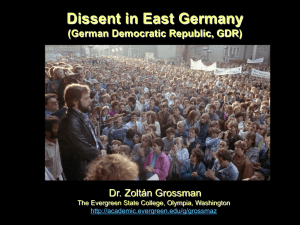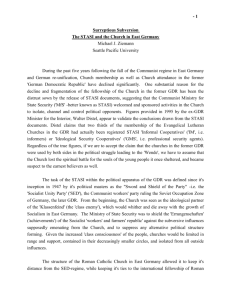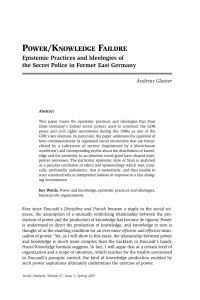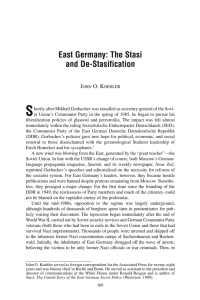`Stasiland shows that fact is often stranger than fiction.` Discuss.
advertisement
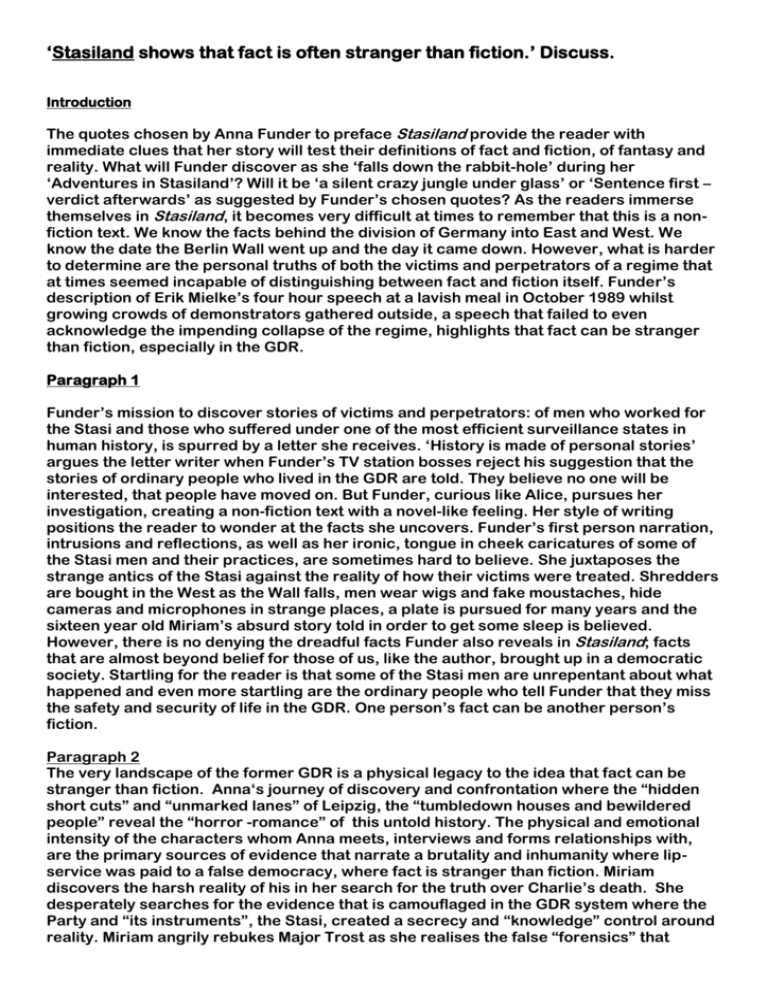
‘Stasiland shows that fact is often stranger than fiction.’ Discuss. Introduction The quotes chosen by Anna Funder to preface Stasiland provide the reader with immediate clues that her story will test their definitions of fact and fiction, of fantasy and reality. What will Funder discover as she ‘falls down the rabbit-hole’ during her ‘Adventures in Stasiland’? Will it be ‘a silent crazy jungle under glass’ or ‘Sentence first – verdict afterwards’ as suggested by Funder’s chosen quotes? As the readers immerse themselves in Stasiland, it becomes very difficult at times to remember that this is a nonfiction text. We know the facts behind the division of Germany into East and West. We know the date the Berlin Wall went up and the day it came down. However, what is harder to determine are the personal truths of both the victims and perpetrators of a regime that at times seemed incapable of distinguishing between fact and fiction itself. Funder’s description of Erik Mielke’s four hour speech at a lavish meal in October 1989 whilst growing crowds of demonstrators gathered outside, a speech that failed to even acknowledge the impending collapse of the regime, highlights that fact can be stranger than fiction, especially in the GDR. Paragraph 1 Funder’s mission to discover stories of victims and perpetrators: of men who worked for the Stasi and those who suffered under one of the most efficient surveillance states in human history, is spurred by a letter she receives. ‘History is made of personal stories’ argues the letter writer when Funder’s TV station bosses reject his suggestion that the stories of ordinary people who lived in the GDR are told. They believe no one will be interested, that people have moved on. But Funder, curious like Alice, pursues her investigation, creating a non-fiction text with a novel-like feeling. Her style of writing positions the reader to wonder at the facts she uncovers. Funder’s first person narration, intrusions and reflections, as well as her ironic, tongue in cheek caricatures of some of the Stasi men and their practices, are sometimes hard to believe. She juxtaposes the strange antics of the Stasi against the reality of how their victims were treated. Shredders are bought in the West as the Wall falls, men wear wigs and fake moustaches, hide cameras and microphones in strange places, a plate is pursued for many years and the sixteen year old Miriam’s absurd story told in order to get some sleep is believed. However, there is no denying the dreadful facts Funder also reveals in Stasiland; facts that are almost beyond belief for those of us, like the author, brought up in a democratic society. Startling for the reader is that some of the Stasi men are unrepentant about what happened and even more startling are the ordinary people who tell Funder that they miss the safety and security of life in the GDR. One person’s fact can be another person’s fiction. Paragraph 2 The very landscape of the former GDR is a physical legacy to the idea that fact can be stranger than fiction. Anna‘s journey of discovery and confrontation where the “hidden short cuts” and “unmarked lanes” of Leipzig, the “tumbledown houses and bewildered people” reveal the “horror -romance” of this untold history. The physical and emotional intensity of the characters whom Anna meets, interviews and forms relationships with, are the primary sources of evidence that narrate a brutality and inhumanity where lipservice was paid to a false democracy, where fact is stranger than fiction. Miriam discovers the harsh reality of his in her search for the truth over Charlie’s death. She desperately searches for the evidence that is camouflaged in the GDR system where the Party and “its instruments”, the Stasi, created a secrecy and “knowledge” control around reality. Miriam angrily rebukes Major Trost as she realises the false “forensics” that “made a mockery” of individualism, privacy and relationships in her quest to find the truth about Charlie’s reported suicide, “The least you people could do is get your story straight.” The power and control of the Stasi challenges Miriam’s very existence as the Communist regime fabricate the details around Charlie’s death and even his funeral; the Stasi “play[ing] with [her] like a mouse”. However, the post -Wall political era offers Miriam little comfort too, as the current authorities “just want to stop thinking about the past…pretend it all didn’t happen.” The continuing legacy of this broken past freezes Miriam to a “living epitaph to a life that was”, her “past stopped when Charlie died”. The “revolution” of democracy continues the blur of fact and fiction in its ambiguity, confusion and apathy towards the past. Paragraph 3 Funder’s continuing quest to uncover the past stories of “resistance” to the “dictatorship” that reveal the reality of human tragedy that have been covered up, is symbolised by the drunks in the park. Funder’s fascination at their prominence as they ironically “shuffle together” around the “statue of Heine” and “share knowledge of a world where each of them once had a place” forces her to face the reality of the new Germany where all is exposed. Julia’s recognises the falsity of her own statement “There were no drunks before the Wall came down…as she “corrects herself” to admit that they were the hidden part of the secrets and fiction in the lying world of “no unemployment” and “no news” .


![Assumptions Checklist [Word File]](http://s3.studylib.net/store/data/005860099_1-a66c5f4eb05ac40681dda51762a69619-300x300.png)


